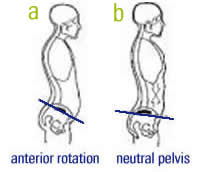Previously, I addressed a client question regarding the “tuck”, or posterior pelvic tilt position, outside of exercise sessions. Click HERE to read Part 1: “Is It Possible To Tuck Too Much?”.
More on pelvic tilts and tucks
The backward, or posterior, pelvic tilt referred to by my client in Part 1 is an exercise position common to several rehabilitative-type workouts. This position is meant to counter an exaggerated anterior pelvic tilt, where the top of the pelvis tilts forward.
 Anterior pelvic tilt, or specifically the top of the pelvis tipping forward, is actually a quite normal postural position. The problem is an excessive anterior pelvic tilt. Rehabilitative exercise works to counter the excessive tilt with consciously tilting the pelvis in the opposite direction.
Anterior pelvic tilt, or specifically the top of the pelvis tipping forward, is actually a quite normal postural position. The problem is an excessive anterior pelvic tilt. Rehabilitative exercise works to counter the excessive tilt with consciously tilting the pelvis in the opposite direction.
Excessive anterior pelvic tilt can contribute mightily to postural dysfunction. It can set a chain of discomfort events into motion: with the deepening anterior tilt, the thigh bones rotate inward, placing increased stress on the inner knee.
This inward rotation of the thigh bone, results in increased weight bearing on the inside of the foot, which puts extra stress and strain on the muscles that roll the inside of the foot down and turn the outside of the foot out. Think fallen arches, and you’ve got the idea. By the way, this problem can also start with the foot and work its way up to a pelvic tilt.
But the problems with excessive anterior tilt don’t stop there. They have a way of working their way all the way up the rest of our posture. When the pelvis tips too far forward, the arch in the lower back increases. As goes the low back, so goes the neck. So the next place for this postural dysfunction to show up is at the neck, resulting in what is called “forward head”.
The prescriptive posterior pelvic tilt
This explains the driving factor behind practicing a posterior pelvic tilt during exercise. Actually, it takes a combination of strategies to correct the problems of the excessive anterior pelvic tilt, to be addressed in another article.
The point here is that though excessive anterior pelvic tilt is a problem that needs to be dealt with specifically to create good posture, overdoing a posterior tuck and countering the natural curves in the back can create problems of its own.
Watch for Part 3 of “Tuck” and Pelvic Tilt Talk: 6 Strategies For Correcting Excessive Anterior Pelvic Tilt
© Lani Muelrath, M.A. 2010 All Rights Reserved




Hi, I would like to watch “Part 3 of “Tuck” and Pelvic Tilt Talk: 6 Strategies For Correcting Excessive Anterior Pelvic Tilt” but the link doesn’t work